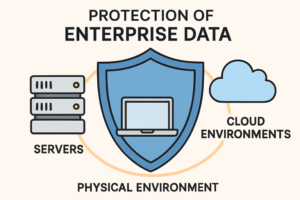Introduction
Today’s enterprises operate in an environment marked by rapidly evolving cyber threats, with the frequency and complexity of attacks increasing significantly over the past decade. As organizations adopt new technologies and shift operations to the cloud, their exposure to security risks expands accordingly. At the same time, global regulations around data privacy and protection continue to tighten, making reactive approaches insufficient. To navigate this landscape, businesses must establish a proactive and comprehensive data protection strategy that mitigates the risk of breaches and penalties and reinforces operational continuity. Utilizing advanced tools that address modern threats—such as ransomware and unauthorized access can help maintain business stability during disruptions. For an in-depth look at such capabilities, refer to https://www.cohesity.com/products/dataprotect/.
Organizations must embrace holistic, end-to-end data protection strategies to construct defenses that keep pace with today’s threat landscape. This requires the right mix of leading-edge technologies, considerable investment in processes, employee training, and a dynamic compliance mindset. A unified and evolving approach where all pieces work together enables organizations to respond quickly to new risks, safeguard customer trust, and meet the stringent demands of modern privacy frameworks. Failing to address data protection comprehensively exposes businesses to operational setbacks, reputational harm, and the mounting costs of regulatory penalties.
Understanding Data Protection
Data protection encompasses the strategies and mechanisms needed to maintain the security, integrity, and confidentiality of an organization’s critical information assets. This means crafting and enforcing wide-ranging policies that govern who can access what data, under which circumstances, and how that data will be treated throughout its lifecycle—from creation to storage, usage, archival, and eventual deletion. It includes not just digital systems but also physical safeguards that prevent unauthorized people from accessing storage facilities, off-site backups, and sensitive hardware. As organizations digitize more functions and store exponentially greater quantities of information, establishing strict data governance and deploying risk-based controls becomes a foundational requirement for any sustainable security posture. Strong data protection also enables organizations to unlock business value from analytics and AI without jeopardizing privacy or compliance.
Implementing Zero-Trust Architecture
Legacy perimeter-based security models are quickly becoming obsolete as modern enterprises break down network boundaries by adopting remote work, cloud migrations, and mobile technologies. Zero-trust architecture addresses these new risks by abandoning the assumption that anything inside the network can be automatically trusted. Instead, it rigorously verifies every user, device, and process requesting access to resources, regardless of origin. Foundational components of zero-trust, such as multi-factor authentication (MFA), least privilege access, and continuous monitoring, sharply reduce the likelihood that a single compromised credential will lead to widespread damage. Role-based access control (RBAC) ensures that employees only receive access to information strictly necessary for their job functions, minimizing potential fallout from internal mistakes or targeted attacks. In practice, this model transforms cybersecurity from a static, reactive effort into a dynamic discipline, capable of adapting to known and emerging threats. In recent years, more than 60% of global enterprises have implemented some form of zero-trust, highlighting its central role in future-proofing organizational security.
Leveraging AI for Threat Detection
The vast scale of modern IT environments and the complexity of cyber threats mean that traditional, manual approaches to threat detection are increasingly inadequate. Artificial intelligence (AI) and machine learning bring transformative capabilities to enterprise security by analyzing immense volumes of security logs, network activities, and endpoint data in real time. AI-driven security systems continuously learn from new attack techniques and adapt their algorithms to spot subtle anomalies quickly, often picking up on early warning signs of an attack well before humans notice. This proactive approach enables security operations teams to identify, isolate, and neutralize threats much faster, reducing the time attackers have to exploit vulnerabilities. AI is equally crucial in automating repetitive but critical tasks, such as triaging alerts and orchestrating responses, freeing security staff to focus on more complex and strategic issues. Organizations that invest in AI and automation consistently report drastically lower breach costs and significantly improved overall resilience.
Ensuring Compliance with Global Privacy Regulations
The rise of comprehensive privacy laws like Europe’s General Data Protection Regulation (GDPR), California’s Consumer Privacy Act (CCPA), and similar frameworks across Asia and South America has elevated data protection to a legal and regulatory imperative. Enterprises must not only understand the requirements of these regulations but also operationalize compliance through transparent policies, consent management, and mechanisms that allow users to request data rectification or erasure easily. Regulatory compliance also involves rigorous data mapping, documenting where and how information is stored, who has access, and what processes govern data sharing with third parties. The consequences of noncompliance go beyond steep monetary penalties, such as GDPR’s fines of up to 4% of global revenue; they also include loss of public trust and lasting reputational harm. Cultivating a compliance-first culture means routinely updating policies, training employees on privacy best practices, and proactively conducting data impact assessments whenever new technologies or business processes are introduced.
Adopting Cloud-Native and Multi-Cloud Protection
As more enterprise data and workloads move to the cloud, ensuring consistent protection across diverse platforms is increasingly challenging. Cloud-native security solutions are designed to harness the integrated security features built into leading cloud providers, automating everything from intrusion detection and data encryption to compliance reporting and backup orchestration. However, organizations leveraging multiple cloud vendors must develop an overarching security strategy that provides unified visibility, standardizes access controls, and coordinates rapid recovery in the event of an incident. Without this, data may be exposed due to inconsistent policies or configuration errors across providers. Modern cloud-centric data protection tools offer granular policy enforcement, automated patching, and the ability to rapidly recover critical assets, ensuring that disruptions whether from cyberattacks, infrastructure failures, or accidental deletions do not cripple core business functions.

Prioritizing Employee Training and Awareness
Despite all technological advances, humans remain one of the weakest links in the cybersecurity chain. Attackers frequently exploit human error, social engineering, and poor judgment to bypass even the most sophisticated defenses. Building a security-aware culture starts with comprehensive onboarding and ongoing training programs, which equip employees to recognize phishing emails, avoid malware traps, and respond appropriately to suspected threats. Simulated attacks and regular testing reinforce proper behavior and identify individuals or teams needing extra attention. Security policies should be clearly documented, accessible, and regularly updated to reflect the latest risks and procedures. By investing in people as much as technology, organizations dramatically decrease the likelihood that a simple mistake will result in a significant data breach and build an environment where everyone shares responsibility for safeguarding sensitive information.
Conducting Regular Privacy Audits
An organization’s data protection strategy must be continuously validated and improved in light of ongoing environmental changes, technology stack, and regulatory requirements. Periodic privacy and security audits are essential to assess whether existing policies, processes, and controls remain effective. A thorough audit involves examining how information is collected, stored, accessed, processed, and eventually deleted while mapping those workflows against regulatory standards and internal guidelines. These audits also help uncover blind spots, such as unexpected vulnerabilities in third-party integrations or gaps in logging practices. The insights gained provide concrete recommendations to strengthen controls, remediate weaknesses, and adapt to emerging threats. By making audits a regular part of the organizational calendar instead of a last-minute scramble before an inspection enterprises can stay continually aligned with best practices and evolving expectations.
Investing in Advanced Encryption Technologies
Encryption is the bedrock upon which secure digital workflows and data privacy are built. While traditional encryption techniques such as encrypting data at rest and in transit are mandatory, forward-looking enterprises are increasingly exploring advanced methods like Homomorphic Encryption (HE), which allows data to be used and analyzed in its encrypted state, and Searchable Encryption (SE), which enables secure searches without exposing sensitive data. These next-generation encryption protocols are vital for compliance and for safely leveraging the power of cloud analytics, artificial intelligence, and machine learning. Maintaining a proactive stance on encryption means staying ahead of evolving attack methods and cryptographic breakthroughs and ensuring all hardware, software, and network layers are continually secured. Together with other foundational controls, strong encryption is non-negotiable for protecting intellectual property, confidential customer data, and vital business records from modern cyber adversaries.
By combining these core data protection strategies, modern enterprises can minimize their risk exposure, achieve regulatory compliance, and preserve business operations, even in the face of aggressive and ever-evolving cyber threats. Proactive, holistic data protection builds lasting trust with customers, partners, and stakeholders and empowers organizations to innovate and grow with confidence in the digital era.


